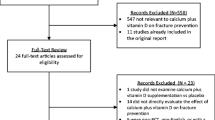Summary
We have reported recently that pharmacologic doses of 1,25 dihydroxyvitamin D3 (1,25(OH)2D3) stimulated bone matrix formation but impaired mineralization. The objective of this study was to determine if parathyroid hormone (hPTH 1-34) or calcitonin (sCT) would mineralize the osteoid induced by 1,25(OH)2D3 in rat long bones. In one experiment, male Sprague-Dawley rats were given daily subcutaneous injections of vehicle: 8 μg hPTH(1-34); 125 ng 1,25(OH)2D3; or both 8 μg hPTH and 125 ng 1,25(OH)2D3 per 100 g body weight for 12 days. In a second experiment, rats received daily injections of vehicle: 2 U sCT; 125 ng 1,25(OH)2D3; or both 2 U sCT and 125 ng 1,25(OH)2D3 per 100 g body weight for 18 days. Calcium (Ca), hydroxyproline (Hyp), and dry weight (DW) of the distal femur and serum calcium, phosphate, and serum bone Gla protein (BGP) were measured. In rats given both 1,25(OH)2D3 and hPTH, total bone DW and Hyp increased (P<.01) without a corresponding increase in bone Ca so that Ca/Hyp decreased 47% (P<.01) from control and remained comparable to values for rats treated with 1,25(OH)2D3 alone. In rats treated with both 1,25(OH)2D3 and sCT, total bone DW and Hyp increased while Ca decreased so that Ca/Hyp decreased 38% from control (P<.05), and remained comparable to values for rats treated with 1,25(OH)2D3 alone. These results indicate that hPTH or sCT, given by intermittent injection to rats for 12 or 18 days respectively, failed to mineralize the osteoid induced by high doses of 1,25(OH)2D3.
Similar content being viewed by others
References
Boyce RW, Weisbrode SE (1983) Effect of dietary calcium on the response of bone to 1,25(OH)2D3. Lab Invest 48:683–689
Hock JM, Gunness-Hey M, Poser J, Olsen H, Raisz LG (1983) Stimulation of undermineralized matrix formation by pharmacologic doses of 1,25 dihydroxyvitamin D3. Calcif Tissue Int 35:643
Narbaitz R, Fragiskos B (1984) Hypervitaminosis D in the chick embryo: comparative study on the activity of vitamin D3 metabolites. Calcif Tissue Int 36:392–400
Gallagher JA, Beneton M, Harvey L, Lawson DEM (1984) Biphasic effects of 1,25(OH)2-vitamin D3 on accumulation of osteoid in rachitic rat bones. Metab Bone Dis and Rel Res 5:209
Deluca HF (1984) The metabolism, physiology, and function of vitamin D. In: Kumar R (ed) Vitamin D: basic and clinical aspects. Martinus Nijhoff Publishers, Boston, p 1
Felsenfeld AJ, Harrelson JM, Gutman RA, Wells SA, Drezner MK (1982) Osteomalacia after parathyroidectomy in patients with uremia. Ann Int Med 96:34–39
Raue F, Deutschle I, Kuntzel C, Ziegler R (1984) Reversible diminished calcitonin secretion in the rat during chronic hypercalcemia. Endocrinol 115:2362–2367
Glowacki J, Deftos LJ (1983) The effects of calcitonin on bone formation. In: Gennari C, Segre G (eds) The effects of calcitonins in man. Masson Italia Editori, Milan, p 133
Schmid RN, Reilly CN (1957) New complexion for titration of calcium in the presence of magnesium. Anal Chem 29:264–268
Chen PS, Toribara TY, Warner H (1956) Microdetermination of phosphorus. Anal Chem 28:1756–1759
Price PA, Nishimoto SK (1980) Radioimmunoassay for the vitamin K-dependent protein of bone and its discovery in plasma. Proc Natl Acad Sci 77:2234–22357
Gunness-Hey M, Hock JM (1984) Increased trabecular bone mass in rats treated with human synthetic parathyroid hormone. Metab Bone Dis and Rel Res 5:177–181
Cheng PM (1969) An improved method for the determination of hydroxyproline in rat skin. Dermatol 53:112–115
Snedecor GW, Cochran WC (1967) Statistical Methods. Iowa State University Press, Ames, Iowa
Parsons, JA (1976) Parathyroid physiology and the skeleton. In: Bourne GJ (ed) Biochemistry and physiology of bone. Academic Press, NY, p 159
Weinstein RS (1982) Decreased mineralization in hemodialysis patients after subtotal parathyroidectomy. Calcif Tissue Int 34:16–20
Endo H, Kiyok M, Kawashima K, Naruchi T, Hashimoto Y (1980) Vitamin D3 and PTH synergistically stimulate bone formation of chick embryonic femur in vitro. Nature 286:262–264
Podbesek R, Edouard C, Meunier PJ, Parsons JA, Reeve J, Stevenson RW, Zanelli JM (1983) Effects of two treatment regimes with synthetic human parathyroid hormone fragment on bone formation and the tissue balance of trabecular bone in greyhounds. Endocrinol 112:1000–100622
Author information
Authors and Affiliations
Rights and permissions
About this article
Cite this article
Gunness-Hey, M., Hock, J.M., Gera, I. et al. Human parathyroid hormone (1–34) and salmon calcitonin do not reverse impaired mineralization produced by high doses of 1,25 dihydroxyvitamin D3 . Calcif Tissue Int 38, 234–238 (1986). https://doi.org/10.1007/BF02556716
Received:
Revised:
Issue Date:
DOI: https://doi.org/10.1007/BF02556716




